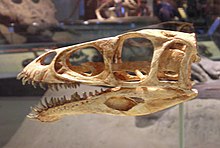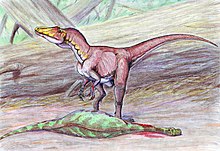Ceratosauria
| Ceratosauria | ||||||||||||
|---|---|---|---|---|---|---|---|---|---|---|---|---|

Aucasaurus skeletal reconstruction |
||||||||||||
| Temporal occurrence | ||||||||||||
| Lower Jurassic to Upper Cretaceous ( Pliensbachian to Maastrichtian ) | ||||||||||||
| 190.8 to 66 million years | ||||||||||||
| Locations | ||||||||||||
|
||||||||||||
| Systematics | ||||||||||||
|
||||||||||||
| Scientific name | ||||||||||||
| Ceratosauria | ||||||||||||
| Marsh , 1884 |
The Ceratosauria are a diverse group of basal (original) theropod dinosaurs . It was spread worldwide and existed from the Lower Jurassic to the Upper Cretaceous . Representatives of this group were small to large, mostly two-legged carnivores , some of which had complex skull ornaments such as headphones. The group of Ceratosauria includes, in addition to a number of basal genera, the Abelisauroidea , which in turn includes the Noasauridae and the Abelisauridae .
The group was only recognized as a separate line of development of the theropods towards the end of the 1980s and their fossil record is still very sketchy to this day. This may partly be due to the fact that they apparently mainly occurred in the southern hemisphere ( Gondwana ), from where the fossil record is generally still very sketchy. In the southern hemisphere, however, they were a very important group and apparently filled the ecological niches of both the large and the small predatory dinosaurs. The smallest known ceratosaur, Ligabueino from the Lower Cretaceous Argentina, with an assumed body size of 60-70 centimeters, is one of the smallest predatory dinosaurs, while Carnotaurus and Aucasaurus from the Upper Cretaceous Argentina with a length of 8-9 meters were probably the largest carnivores in their ecosystems .
Originally the Coelophysoidea were classified within the Ceratosauria. Today this grouping is mostly regarded as paraphyletic , the Coelophysoidea are therefore classified outside of the Ceratosauria.
features
Ceratosauria were small to large theropods, some forms reached a length of ten meters.
Trunk and limbs skeleton
They had 17 ( Elaphrosaurus ) to 22 ( Carnotaurus ) presacral vertebrae (vertebrae in front of the sacrum ), including ten cervical vertebrae , which formed an S-shaped neck. The exact number of caudal vertebrae is not known, for Ceratosaurus 50 are given. Their vertebral anatomy was more similar to that of the Tetanurae than that of the Coelophysoidea . The bones of the back legs of the Ceratosauria are hollow and thin-walled. They were characterized by greatly shortened arms, which in some forms, such as Carnotaurus, were so much reduced that they probably had hardly any function.
skull

The skulls were large, tall, the muzzle short and broad. The skull windows were often twice the size of the eye sockets . In addition, numerous special adaptations to the skulls of different groups are noticeable, such as the horn on the nasal bone of Ceratosaurus and horns on the frontal bone of Carnotaurus , Majungasaurus and other Abelisaurids. The maxillary is short and, with the exception of that of the Noasauridae, tall. The frontal bones have grown together and with the parietal bones .
Systematics
History of Research and the Term Neoceratosauria
The group Ceratosauria was first set up in 1884 by Othniel Charles Marsh , and initially only contained the Ornithomimidae and the Ceratosauridae . Marsh set up the Ceratosauridae earlier in the same year - initially a redundant group that contained Ceratosaurus as the only representative. In the period that followed, the name Ceratosauria found little use, and it was controversial which genera should be classified within this group. The name was only established at the end of the 20th century: Rowe and Gauthier (1990) use the name Ceratosauria to summarize the Coelophysidae family ( Dilophosaurus , Coelophysis and Megapnosaurus ) and the genus Ceratosaurus . Later, the close relationship between Ceratosaurus and the Abelisauridae became obvious, which is why Novas (1992) established a new group within the Ceratosauria, the Neoceratosauria : This should include Ceratosaurus , Noasaurus and the Abelisauridae, excluding the Coelophysidae. Since then, the Ceratosauria have been considered a group of basal theropods, which should include the Coelophysidae (or the somewhat more comprehensive Coelophysoidea ) on the one hand, and the Neoceratosauria, which only appeared later in the fossil record, on the other. Today most researchers consider the grouping Neoceratosauria + Coelophysoidea to be paraphyletic : The Coelophysoidea split off from the main line of development of the theropods even earlier and independently of the Neoceratosauria. The Coelophysoidea are therefore classified outside of the Ceratosauria, whereby the name Neoceratosauria is often understood as a synonym of the name Ceratosauria.
The following cladogram shows the original definition of the ceratosauria with the subgroups Coelophysoidea and Neoceratosauria, which most researchers have rejected today :

| Theropoda |
|
||||||||||||
|
|
External system
The Ceratosauria split off from the main development branch of the theropods very early. They form the sister group of the Tetanurae , to which most other theropods, including birds, belong. Together, the Ceratosauria and the Tetanurae form the taxon Neotheropoda . Another group of basal theropods, the Coelophysoidea, form the sister group of the Neotheropoda.
| Theropoda |
|
||||||||||||
|
|
Internal system
Within the Ceratosauria there are, in addition to the basal, mainly Jurassic forms, the Abelisauroidea, which were particularly widespread in the southern continents in the Cretaceous period. They include all theropods that are more closely related to Carnotaurus sastrei than to Ceratosaurus nasicornis . The Abelisauroidea are divided into Noasauridae and Abelisauridae. The latter are defined as Abelisaurus comahuensis and Carnotaurus sastrei , their most recent common ancestor and all of their descendants. The Noasauridae were initially only created for Noasaurus leali . Today they are assigned a few other genera.
- Ceratosauria
literature
- Ronald S. Tykoski, Timothy Rowe : Ceratosauria. In: David B. Weishampel , Peter Dodson , Halszka Osmólska (eds.): The Dinosauria . 2nd edition. University of California Press, Berkeley CA et al. 2004, ISBN 0-520-24209-2 , pp. 47-70.
- Oliver WM Rauhut : The interrelationships and evolution of basal theropod dinosaurs (= Special Papers in Palaeontology. Vol. 6). The Palaeontological Association, London 2003, ISBN 0-901702-79-X , Google books .
- Matthew T. Carrano, Scott D. Sampson, Catherine A. Forster: The Osteology of Masiakasaurus knopfleri, a small Abelisauroid (Dinosauria: Theropoda) from the Late Cretaceous of Madagascar. In: Journal of Vertebrate Paleontology. Vol. 22, No. 3, 2002, ISSN 0272-4634 , pp. 510-534, doi : 10.1671 / 0272-4634 (2002) 022 [0510: TOOMKA] 2.0.CO; 2 .
Individual evidence
- ^ Gregory S. Paul : The Princeton Field Guide To Dinosaurs. Princeton University Press, Princeton NJ et al. 2010, ISBN 978-0-691-13720-9 , pp. 77-85, online ( memento of the original from July 13, 2015 in the Internet Archive ) Info: The archive link was inserted automatically and not yet checked. Please check the original and archive link according to the instructions and then remove this notice. .
- ↑ Ronan Allain, Ronald Tykoski, Najat Aquesbi, Nour-Eddine Jalil, Michel Monbaron, Dale Russell , Philippe Taquet : A basal abelisauroid from the late Early Jurassic of the High Atlas Mountains, Morocco, and the radiation of ceratosaurs. In: Journal of Vertebrate Paleontology. Vol. 27, No. 3, 2007, ISSN 0272-4634 , pp. 610-624, doi : 10.1671 / 0272-4634 (2007) 27 [610: AADTFT] 2.0.CO; 2 .
- ^ A b c Matthew T. Carrano, Scott D. Sampson: The Phylogeny of Ceratosauria (Dinosauria: Theropoda). In: Journal of Systematic Palaeontology. Vol. 6, No. 2, 2008, ISSN 1477-2019 , pp. 183-236, doi : 10.1017 / S1477201907002246 .
- ↑ a b c Paul Sereno : Ceratosauria. (No longer available online.) In: Taxon Search. Archived from the original on April 24, 2014 ; accessed on August 7, 2014 . Info: The archive link was inserted automatically and has not yet been checked. Please check the original and archive link according to the instructions and then remove this notice.
- ^ A b Timothy B. Rowe, Jacques Gauthier : Ceratosauria. In: David B. Weishampel, Peter Dodson, Halszka Osmólska (eds.): The Dinosauria . University of California Press, Berkeley CA et al. 1990, ISBN 0-520-06726-6 , pp. 151-168.
- ^ Jorge O. Calvo , David Rubilar-Rogers, Karen Moreno: A new Abelisauridae (Dinosauria: Theropoda) from northwest Patagonia. In: Ameghiniana. Vol. 41, No. 4, 2004, ISSN 0002-7014 , pp. 555-563.
- ↑ Fernando E. Novas : La evolución de los dinosaurios carnívoros. In: José Luis Sanz García, Ángela Delgado Buscalioni (ed.): Los dinosaurios y su en torno biótico. Actas. II Curso de Paleontología en Cuenca, 10 a 12 de julio de 1990. Instituto Juan de Valdes, Cuenca 1992, ISBN 84-86788-14-5 , pp. 125-163.
- ↑ Bárbara Sánchez-Hernández, Michael J. Benton : Filling the ceratosaur gap: A new ceratosaurian theropod from the Early Cretaceous of Spain. In: Acta Palaeontologica Polonica. in press, available online 23 October 2012, ISSN 0567-7920 , doi : 10.4202 / app.2011.0144 .
- ↑ Cristiano Dal Sasso, Simone Maganuco, Andrea Cau: The oldest ceratosaurian (Dinosauria: Theropoda), from the Lower Jurassic of Italy, sheds light on the evolution of the three-fingered hand of birds. PeerJ 6: e5976 doi: 10.7717 / peerj.5976
- ^ Gregory S. Paul: The Princeton Field Guide To Dinosaurs. Princeton University Press, Princeton NJ et al. 2010, ISBN 978-0-691-13720-9 , p. 77, online ( memento of the original from July 13, 2015 in the Internet Archive ) Info: The archive link has been inserted automatically and has not yet been checked. Please check the original and archive link according to the instructions and then remove this notice. .
Web links
- The Paleobiology Database Ceratosauria
- TaxonSearch - Database for SupAGENeric Taxa & Phylogenetic Definitions by Paul C. Sereno


